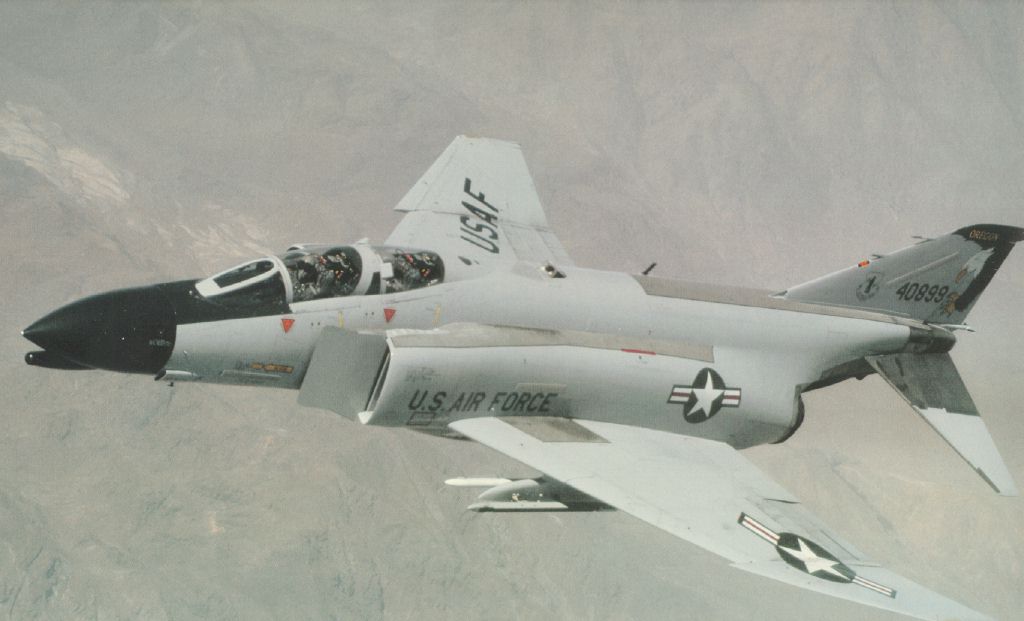


Introduction: The McDonnell Douglas F-4 Phantom II is without a doubt a classic multi-role combat aircraft although it has taken a lot of development to get it there. Originally designed as a gunless all weather interceptor for the USN it was to engage "bogies" at beyond visual range with AIM-7 Sparrow AAM's. To do that it had to be big to carry the missiles, enough performance for a rapid interception and substantial fuel to allow for a reasonable on station time. In addition it required two crew members, one just for managing the complex air combat radar. With the F-4 taking almost all performance records in sight it soon attracted the attentions of the USAF whose F-4C development reached squadrons during the early years of Vietnam. Vietnam however proved that BVR air combat was still in its infancy and the Sparrow's kill ratio compared to tests had dropped to 1 in 14.
Thus the F-4E was redesigned into the multi-role combat aircraft with the capability for carrying AIM-9 Sidewinder AAM's and in later models a fixed M61A1 gun. In addition the radar was upgraded to the solid-state APQ-120 and more powerful J79 engines were fitted to cope with the increased weight.
The next major variant was the RF-4C, a sophisticated unarmed reconnaissance system which replaced the RF-101 Voodoo. With a suite of cameras in a lengthened nose, IR linescan, SLAR, a mapping radar, ECM/HF equipment and in later models TEREC pods the RF-4C provided the USAF its main reconnaissance aircraft with 505 models built serving with 6 squadrons in Europe, the Pacific and the USA plus a further 6 aircraft in the ANG.
During the Vietnam War the term Wild Weasel had become synonymous with the SAM-suppression F-105 Thunderchiefs. Their successors were yet another version of the F-4; rebuilt F-4E airframes to F-4G Wild Weasel standard which entered service in October 1978. This became the most expensive Phantom version with 52 aerials designed to detect, identify and locate enemy radars. The principal external differences of the F-4G lie in various pods under the nose, at the top and bottom of the fin and the gun being removed. However the F-4G can carry AGM-78 Standard ARM, AGM-88 HARM, AGM-45 Shrike and AGM-65 Maverick and for self-protection it can still carry three AIM-7 Sparrows the fourth missile station taking an ALQ-199 ECM pod.
Other models included the F-4J, an improved F-4B for the USN, an even more advanced F-4N, the F-4K for the RAF with Spey turbofans and Sky Flash AAM's, F-4F pure interceptor for the Luftwaffe, the F-4EJ for Japan. The final development of the F-4 is the "Super Phantom 2000" which all though designed by Boeing and Pratt & Whitney is being carried out by Israel. This involves a replacment of the engines for PW1120's, a 1120gal (5090l) conformal tank under the fueslage and changes to the airframe and avionics. The USA has been unwilling to commit to this programme with the massive defence cuts of the early 1990's massively reducing the numbers of F-4's although many other countries have signed to the project as over 2000 F-4's are estimated to be in service by the year 2000. In total 5173 F-4's were built worldwide, a testimony to this classic combat aircraft.
F-4's have also accounted for the most number of air to air kills of any aircraft since World War 2, at the last count the total stood at 238, the majority of victims being Soviet designs. These are known to be as follows: 53.5 Mig-17 Fresco's, 10 Mig 19 Farmer's, 109.5 Mig-21 Fishbed's, 2 An-2 Colt's, the rest are identified as Mig's and are victims of Israeli Phantom's. The weapons used in these victories vary as follows: AIM-7 Sparrow 64, AIM-9 Sidewinder and Shafrir 97.5, Falcon 5, M61A1 gun 22.5 and manoeuvering - either luring the opponent out of fuel or past the point to control 5 and the remainder are unknown and are again Israeli in origin.
Type: Originally carrier-based all weather interceptor; now multi-role fighter, attack, ECM, reconnaissance aircraft.
Crew: Two seated in tandem in Martin-Baker Mk H7 ejector seats.
Engines: 2 17900lb (8119kg) General Electric J79-GE-17A afterburning turbojets.
Span: 38ft 5in (11.7m)
Length: 58ft 3in (17.76m)
Height: 16ft 5.5in (5.02m)
Wing Area: 530sq ft (49.2m/2)
Maximum Speed: 1500mph (2415km/h) (Mach 2.2) over 35000ft (10670m)
Service Ceiling: 60000ft (18290m)
Climb Rate: 28000ft/min (8534m/min)
Combat Range: 1750miles (2817km)
Ferry Range: 2600miles (4184km)
Fixed Armament: 1 20mm General Electric M61A1 gun with 640 rounds
Disposable Armament: 4 medium range AAM's (AIM-7 Sparrow, Sky Flash or AMRAAM) semi-recessed under fuselage; 4 wing and 1 centre-line pylons for tanks, bombs or other stores to a total weight of 16000lb (7257kg).
Electronics and Operational Equipment: AN/APN-155 radar altimeter, AN/AJB-7 all-altitude bombing system, AN/ASN-46A navigation computer, AN/ASN-63 inertial navigation system, AN/ASQ-91 weapon-release system, AN/ASG-26 lead-computing optical sight, AN/APR-36 radar homing and warning receiver, AN/ASA-32 automatic flight control system, AN/APQ-120 radar fire control system and CPK-92A computer.
History: First flight (XF4H-1) 27th May 1958, service delivery (F-4A) February 1961, first flight (Air Force F-4C) 27th May 1963, F-4E 30th June 1967, F-4G 1976.
Users: Egypt, Germany, Greece, Iran, Israel, Japan, Saudi Arabia, South Korea, Spain, Turkey, UK (RAF,RN), USA (USAF,USN,USMC,ANG).
Quotes about the F-4 Phantom II:
Bill Gunston "McDonnell designed the greatest fighter of the postwar era"
Barry C Wheeler "The F-4 Phantom II will surely rank as one of the classic fighters of all time"
John Jordan "The Phantom proved to be outstanding in all respects"
Bill Gunston "By far the most important fighter in the non-Communist world the past 20 years, the F-4 has an evergreen quality of sheer capability"
Mike Spick "It is not surprising that the versatility of the Phantom has become a byword"
Bill Gunston "Unquestionably the greatest fighter of the 1960's, and one of the greatest combat aircraft of all time"
Mike Spick "The Phantom is widely regarded as the worlds most versatile fighter"